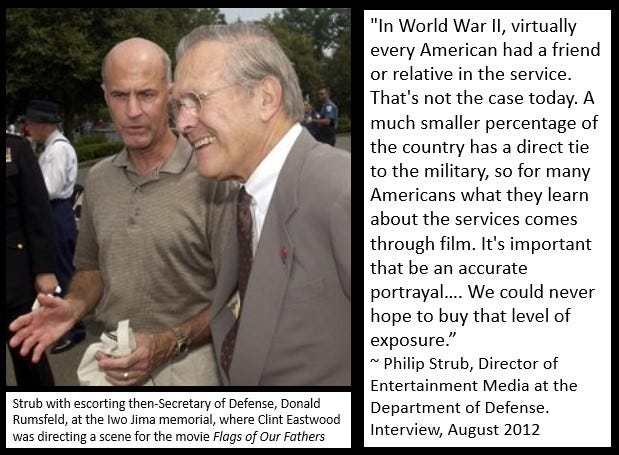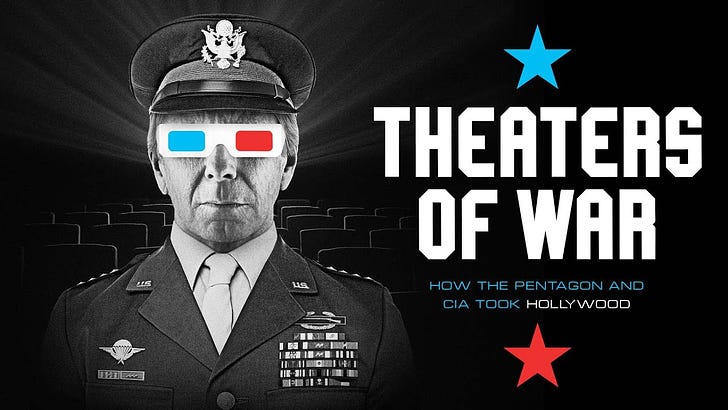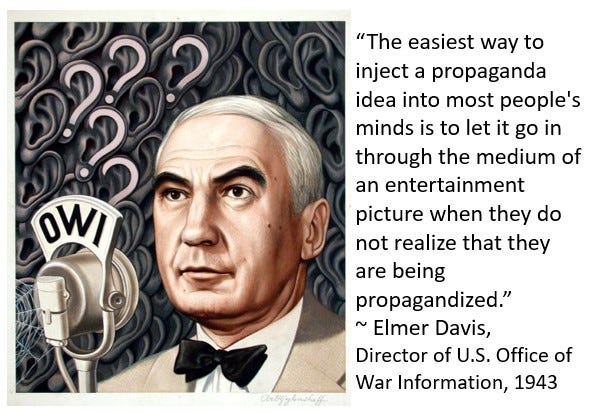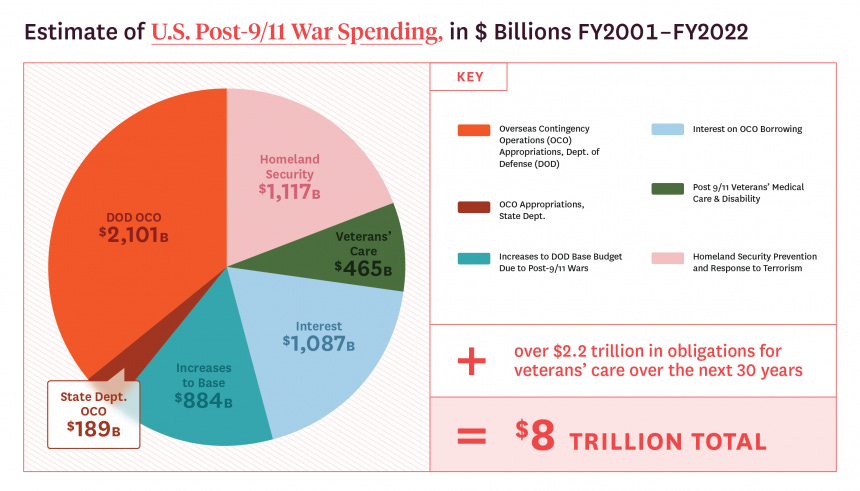The Top Gun Effect: Why Hollywood Movies Matter to the U.S. Military
Part III of a series exploring the intersection of movies and the U.S. military
The following is the third of a series dealing with popular American culture and military service. The second piece is “Going to the Movies...with the Pentagon.”
Though some dismiss claims of those in cultural studies that movies and popular culture shape us, leaders at the Department of Defense have explicitly stated that they see movies as a means of instructing or educating the public about warfare and the U.S. military.
In 2012, then Director of Entertainment Media at the Department of Defense, Philip Strub, said that the military’s involvement in movie making was motivated by the awareness that, today, fewer Americans have direct knowledge and experience of the military than during the World War II era. The reason the Department of Defense takes great interest in Hollywood movies is because movies are where so many Americans learn about war and the U.S. military. Strub said:
"In World War II, virtually every American had a friend or relative in the service. That's not the case today. A much smaller percentage of the country has a direct tie to the military, so for many Americans what they learn about the services comes through film. It's important that be an accurate portrayal."
Of course if objective historical accuracy were a matter of concern then we might expect a historian or panel of historians to make decisions about whether or not a film is approved for support. We would also expect the process of determining whether or not that support was conferred would be transparent and accompanied by publicly accessible criteria allowing us to understand the decision-making process. We might also expect some explanation as to what exactly has to be accurate since so many of the movies the Pentagon supports are fictional stories.
Following the lip-service to accuracy Strub makes it clear that the military’s main concern is curating a favorable cinematic image. Referring to the power of Hollywood movies to project a favorable image of the U.S. military, Strub candidly admitted:
“We could never hope to buy that level of exposure.”
Let us not allow these words to glide past us without truly comprehending their significance. The man who ran the Department of Defense’s entertainment office for 29-years, from1989 through 2018, believed that Americans learn about war through the movies and views them as a way to market the military to that public. Strub's appreciation for the power of popular culture to shape public consciousness is likely informed by his graduate level education in the humanities. After earning a BA in political science, Strub went on to earn a master’s degree in cinema production from University of Southern California, in 1974. He then joined the Navy where he eventually worked in the public affairs office, before heading up the Pentagon’s entertainment office.
Strub’s belief in the pedagogical purpose of the pentagon’s involvement in movies is not anomalous. Roberts, the Department of Defense’s current director of entertainment media, said the entertainment office’s “mission” is to
“inform and educate the public, both the domestic and the foreign public, on the roles and missions of the Department of Defense. That's why we exist, really, to make sure that Americans know that their taxpayer dollars are being used in good stewardship.”
According to Roberts, the other dimension of the Defense Department’s role in movie making is to “to project and protect the credibility and image of the Department of Defense in the entertainment space. And for us, the entertainment space is vast and includes movies, TV shows, documentaries, videos, games, live events and even a bit of social media.”
"We need to make sure that we're good stewards of the taxpayers' money and their resources. And we only utilize those resources and make them available for things that are really going to be seen in the public eye.“
Such an effort takes the form of the Defense Department helping to make Captain Marvel (2019) and two Captain America movies. The Air Force was actively involved in helping to make Captain Marvel. According to the military branch’s press release,
“Airmen partnered with Marvel Entertainment through the Air Force Public Affairs Entertainment Liaison office, which offered direct access to resources including personnel, aircraft and equipment, technical assistance and military advice and locations. This ensured the portrayal of the Airmen and missions were plausible and realistic.”
The Air Force also placed pre-movie ads in more than 3,600 theaters nationwide showing Captain Marvel and teamed up with the star of the film for press events.
The entertainment office had a similar partnership with the makers of X-Men: First Class (2011). After allowing filmmakers to utilize military equipment for the movie, the Pentagon’s entertainment office used the movie to produce recruitment advertisements connecting military service to superhero adventure and played the ads in theaters.
In a 2011 interview, Philip Strub said:
"The relationship between Hollywood and the Pentagon has been described as a mutual exploitation. We're after military portrayal, and they're after our equipment."
This “mutual exploitation” generates revenue for movie makers and stimulates interest in joining the armed services. According to the military, exit polls found that 17 to 24-year old movie goers who saw the X-Men: First Class ad were 25% more likely to say they would consider joining the Army.
Movies and the Military
These kinds of active partnerships are not new. Just over 100 years before the Department of Defense partnered to make Captain Marvel, the U.S. government created the Committee on Public Information, under president Woodrow Wilson in 1917, to generate greater support in the public for World War I. Eventually the CPI created the Division of Films which facilitated production of propaganda movies including Pershing's Crusaders (1918), America's Answer (1918), and Under Four Flags (1918).
One of the members of the CPI was none other than Edward Bernays, a pioneer in public relations who openly advocated for "propaganda" as a necessary and useful mechanism for those in power to direct the broader public.
Though the CPI was soon disbanded, government propagandizing began anew during World War II. In 1941, the U.S. Office of War Information (OWI) was formed under Franklin D. Roosevelt. CBS newsman and journalist Elmer Davis was named as the director, who helped steer Hollywood movies to normalize support for military service and overseas intervention. Davis explained his view about the power of movies to impact viewers in a 1943 correspondence with the U.S. Director of Censorship, Byron Price:
"The easiest way to inject a propaganda idea into most people's minds is to let it go in through the medium of an entertainment picture when they do not realize that they are being propagandized."
The Top Gun Effect
By the 1960s and 1970s, the Vietnam war had significantly tempered the public’s enthusiasm for warfare. Hollywood’s representation of warfare became increasingly complex as exemplified by films like Deer Hunter (1978), Coming Home (1978), and Apocalypse Now (1979). This is why Tom Cruise’s 1986 movie, Top Gun, which came out the same year as Oliver Stone’s Platoon, is seen as marking a shift in Hollywood representation of the U.S. military.
Strub contends that Top Gun was a “milestone” movie “because it signified the rehabilitation of the military as acceptable subject matter, in a positive context.”
"It showed, to me and a great many other people, that you could make a film that portrayed the U.S. military in a positive way and make money, and not become a pariah in Hollywood. I'm not saying it was the first picture to do that, but I'm saying it was the most important picture that symbolized that change in public opinion.”
This rehabilitation was not a naturally occurring event, but rather, in part, the result of conscious effort by the U.S. military. The Navy made one of its Topgun instructors available to actors and crew for the movie. Military assets such as F-14s and aircraft carriers were also made available. The Navy even helped convince Tom Cruise to take the lead role.
According to producer Jerry Bruckheimer, he and the Navy arranged for Cruise to fly with the Blue Angels at the Naval Air Facility in El Centro, California.
“He drove up there on his motorcycle and he had just finished a movie with Ridley Scott, Legend, and his hair was long and in a ponytail. And they took one look at him and thought, we’re going to give this hippie a ride. They took him up on an F-14 and flipped him and did all kinds of stunts to turn him around and make sure he never got back in a cockpit. But it was just the opposite. He landed and he walked over to a phone booth and called me up and said, ‘Jerry. I’m making the movie. I love it.’ He became an amazing aviator himself. He can fly just about any plane they can make.”
Top Gun went on to be the top grossing movie of 1986, earning Paramount Pictures more than $178 million, beating out movies like Crocodile Dundee, The Karate Kid Part II, Aliens, The Color Purple, and Platoon at the box office.
The Navy, for its part, used the 1986 blockbuster, Top Gun, to boost recruitment and its public image. Some Navy recruiters set up Q&A booths outside of theaters, and one Navy recruiter said “several” people attributed their interest in joining the service to the movie. The power of a movie to excite interest in joining the service was later termed the “Top Gun Effect.”
We can turn to none other than the current head of the Pentagon’s entertainment office for evidence of the “Top Gun Effect.” Roberts said Top Gun was a factor in his decision to join the Air Force, at the age of 17.
“I know I saw it in the theaters. I was 17 years old, and I joined the Air Force, I enlisted in the Air Force as a aircraft maintainer not long after I saw that movie.”
The Top Gun Redux
The 2022 sequel to the first Top Gun movie has more than duplicated the success of the 1986 release. Top Gun: Maverick cost about $170 million to make and is the top grossing movie of the year at more than $716 million. The nearest competitor at the box office is more than $300 million behind.
As with the first, the military was significantly involved in the making of Maverick. To gain vital government support, filmmakers had to accept the stipulation that the military be able to "weave in key talking points relevant to the aviation community." What those “talking points” are we do not know.
What we know is that Tom Cruise plays Pete “Maverick” Mitchel, a flight instructor tasked with training a group of elite fighter pilots to take on an unnamed enemy. This enemy is said to have “fifth-generation” fighter jets that require our pilots to launch a preemptive sneak attack. This is true Hollywood yarn spinning. Our nation stands as the lone military hegemon.
If anyone was going to have “fifth-generation” fighter jets it would be the U.S.A. Lockheed Martin would be sure of that. Indeed, the military contractor, Lockheed Martin’s logo is prominently displayed throughout the new Top Gun movie. The company itself boasts of its partnership with Top Gun’s filmmakers. "We partnered with the Top Gun: Maverick film’s creative team to collaborate on bringing our expertise in hypersonic capabilities and aircraft design to the big screen."
You might ask, what good is that marketing since most of us are a little short of the kind of cash needed to buy our own military hardware? One simple answer is that there is no greater consumer of military commodities in the world than the citizens of the United States of America. As Jonathan Turley writes,
"Shaping public opinion is not some idle pastime for the U.S. military. Funding and recruitment depend on favorable public impressions—impressions often shaped in subtle, indirect exposures to films. The military's decline after the Vietnam War galvanized its commitment to stay active and vigilant in presenting (or procuring) positive images of its work."
It takes money to fund the largest military organization in human history, and funding requires taxpayer support. Maintaining that support presents challenges when, unlike other nations, elected leaders claim not to have enough money to fund healthcare, education, and vital infrastructure programs. Thus the importance of rendering economic support for the military an unquestioned fact of American life. Money spent on helping to produce fawning depictions of U.S. armed services facilities broader social acceptance of unparalleled military spending.
Production Costs of the U.S. Military
To understand why the U.S. military is so interested in Hollywood movies, we need to understand how much it costs to produce the most power military in the history of human civilization. As much as it costs to make a movie, nothing quite rivals the cost of maintaining the U.S. military. A chief concern of the Defense Department is maintaining large scale social consent for a military budget that drastically outsizes all of its rivals. In 2021, the United States spent $801 billion dollars on military spending. The Biden administration requested congress to approve an $886 billion defense budget for 2024, an increase of $28 billion from the previous year.
To put this into perspective, consider that the U.S. spent more than two-and-a-half times what China spent in 2021. U.S. spending is greater than that of China and the next eight countries with the highest military budget.
Meanwhile the Department of Defense is culturally insulated from criticisms over government spending and waste. This despite the fact the Department of Defense has failed each of the audits it has been subjected to. In 2022, 19 of the 27 military agencies under the Department of Defense failed to provide an accurate accounting of their use of taxpayer dollars or assets. In the past the Pentagon has admitted to buying $436 hammers, $640 toilet seats, $999 pliers, and $117 soap dish covers. Then there was the case of the Air Force’s $10,000 toilet seat covers.
While we are encouraged to believe our pop cultural experiences should not be taken too seriously, people like Edward Bernays, Elmer Davis, and Philip Strub go about putting our fun to work in the service of their beliefs and goals.
Military spending comprises 11% of all federal spending and is more than 46% of all discretionary spending, that part of the budget that Congress decides how to spend, annually. Another 6% is spent on Veterans' benefits. By contrast, just under 10% or $159 billion of discretionary spending is spent on education.
According to the National Alliance to End Homelessness, more than 580,000 people experienced homelessness in January 2020. This figure includes 171,000 people in families, 37,000 veterans, 34,000 unaccompanied youth, and 110,000 chronically homeless individuals. Giving each homeless person $15,000 a year for housing would cost less than $9 billion a year. Giving them $200,000 to purchase an apartment or home would cost less than $117 billion.
If this seems like a lot of money consider that, according to Brown University’s Cost of War Project, the U.S. has “spent and obligated $8 trillion dollars on the post-9/11 wars in Afghanistan, Pakistan, Iraq, and elsewhere,” between 2001 and 2022.
A 2021 study from the Institute for Policy Studies, contends that the U.S. spent more than twice that. The report contends that the U.S. has spent $16 trillion on military spending, of which $7.2 trillion went to military contractors. An additional $3 trillion was spent on veterans' programs.
The “war on terrorism” was purportedly declared to prevent another horrific September 11, in which terrorists murdered 2,977 civilians in 2001. But if the aim was to protect human life, we are entitled to ask why legislators did not and do not respond with the same urgency to address the tens of thousands who die annually due to inadequate healthcare—nearly 4,000 in the state of Florida, alone.
Thinking Critically about Popular Culture
The U.S. military's use of Hollywood movies to "educate" the public about warfare and military service teaches an important secondary lesson: that the general public is mistaken in embracing the common sense belief that movies and entertainment are “just for fun.” Our narrow conception of education, as something that occurs in tightly controlled environments designated as “schools” leaves us vulnerable to manipulative influence. Those who wish to sway our thinking and market their beliefs or products are well aware of the power of entertainment to bypass rational judgment to engage unthinking feelings and generate thoughts, attitudes, and even behaviors.
Humanistic thinkers throughout the ages have long recognized the power of culture to shape human beings. As Charles E. Silberman pointed out in his examination of U.S. education, Crisis in the Classroom: The Remaking of American Education (1970), we have lost sight of a long recognized reality, that we are educated by multiple cultural forces and not only by those places we call “schools.”
“From Plato to Rousseau to Jefferson to the early John Dewey…almost everybody who wrote about education took it for granted that it is the community and the culture—what the ancient Greeks called paideia—that educates. The contemporary American is educated by his paideia no less than the Athenian was by his. The weakness of American education is not that the paideia does not educate, but that it educates to the wrong ends.”
While we are encouraged to believe our pop cultural experiences should not be taken too seriously, people like Edward Bernays, Elmer Davis, and Philip Strub go about putting our fun to work in the service of their beliefs and goals. A student told me that when he first watched the Top Gun sequel, his immediate reaction was, “It would be awesome to fly a jet like that.” Knowing that some of the people involved in helping to make the movie want to stimulate interest in military service in young men like him is an important piece of information that facilitates deeper thought and understanding about media and politics.
We cede too much of our agency when fail to recognize how much is at stake as we sit before “the big screen.” And whereas the government transparently stated its role in helping to make World War I propaganda movies, the fingerprints and aims of government “support” are more difficult to find and make sense of in contemporary Hollywood blockbusters. In failing to critically examine popular movies and other features of popular culture, we unknowingly permit cultural forces with undisclosed vested interests to at least partly shape our lives.
If you enjoyed this post please share it with others and like it by clicking the heart icon. Be sure to subscribe if you haven’t already.
Invite Dr. Nall to Speak
Dr. Nall delivers energetic live presentations and engaging workshops on the subjects featured in Humanities in Revolt. Those interested in booking a workshop or talk can get in touch through Facebook or by leaving a comment.
Subscribe
Subscribers will receive periodic posts pertaining to the broad domain of humanistic inquiry, from the insights of great thinkers throughout human history, the meaning and importance of critical thinking and ethics, the underappreciated poetry in everyday existence, to contemporary cultural analysis and the ongoing struggle to combat human oppression and violence. You will also have the opportunity to engage the author and our online community in dialogue about each post.
Why get a paid subscription?
Paid subscriptions directly support Dr. Jeffrey Nall’s efforts to produce and share publicly accessible independent scholarship and analysis. Supporting donations can also be made through PayPal. For more about my work go to JeffreyNall.com and find me on Twitter, Facebook, and Instagram.

















